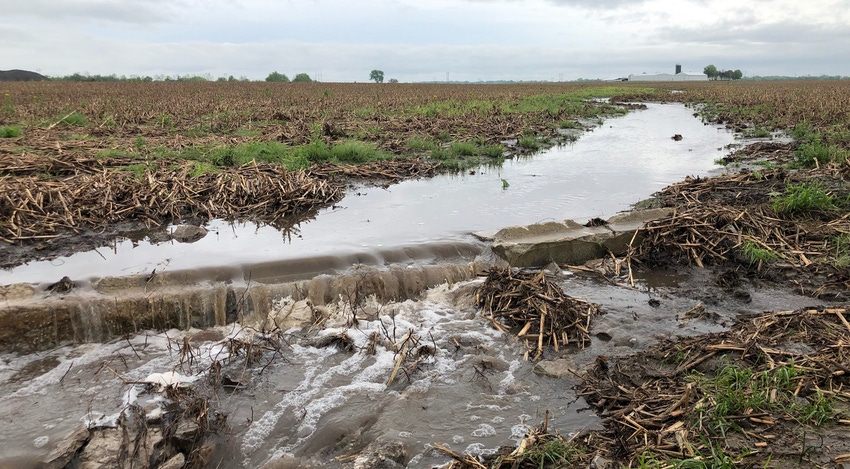
Illinois farmers know it’s wet out there. But how wet has it really been?
Between Jan. 1 and May 10, Illinois weather stations experienced an average of 45% more rain than the 1981-2010 norm. It’s also been about five years since accumulated rain delayed planting this late into the spring season for large swaths of the Corn Belt and Mississippi Delta.
Since the first of the year, some areas of southern Illinois have seen more than 25 inches of rain, according to data from the Midwest Regional Climate Center. To the west, places like Geneseo were 8 inches above where they were last year on May 10.
A trend that will continue
Kaiyu Guan, a natural resources and environmental sciences professor at the University of Illinois, says to expect more frequent wet springs like 2019, with likewise more frequent heavy rains in the future.
“It’s actually probably going to continue picking up in frequency over the course of years,” says Guan, who’s also a Blue Waters professor at the National Center for Supercomputing Applications. “Climate models have predicted the increase in excessive rain we’ve seen so far and anticipate the trend will continue.”
With this trend in mind, Guan partnered with other campus researchers, including ag economist Gary Schnitkey, to look at the past 30 years of crop insurance claims and other streams of data, such as soil properties and historical weather, for the U.S.
They determined that in locations with poorly drained soils and cooler conditions, rain can be as damaging to corn yield as drought. In particular, the Dakotas, southern Minnesota and western Iowa have all, in the past 30 years, had years where the average farmer lost just as much corn yield to rain as they lost to drought in dry years.
The study published in Global Change Biology at the end of April shows that, for certain years, excessive rainfall reduced U.S. corn yield by as much as 34% relative to the expected yield in some areas. Drought and excessive heat caused a yield loss of up to 37% during some years.
“The numbers come from crop insurance indemnity data, so they don’t lie,” Guan says, adding excessive rainfall affected more counties than drought in the 30 years of insurance data, but on average for each case, the affected area and damage were less than what drought caused.
Losses attributed to rain have a “weaker signal,” as average yield for the county recorded for insurance claim purposes isn’t dragged down as much as during drought. Some farms, for example, could be tile-drained, while many other areas in the county could be at higher elevations and avoid the worst accumulations that delay planting the longest.
Because of this, the study authors are calling for changes to risk management plans by both government and farmers.
“As rainfall becomes more extreme, crop insurance needs to evolve to better meet planting challenges faced by farmers,” Schnitkey says.
Tile efficiency
Illinois has more than 10 million tile-drained acres, and Guan says farmers following the practice are on the right path for preparing for a wetter present and future. However, there are existing century-old tile mains that are much less effective than modern draining.
Without knowing where tiled land is and how effective or old the piping is, Guan says there’s no good way to evaluate Illinois tile’s impact on local and regional scales. Therefore, his team’s analysis focused on the county scale and up, but he says farmers can look in their own fields to see if they have an old system, if water is pooling, and if they need to look at investing in new drainage.
“If you have efficient tile, it definitely helps. But it also helps to go out and look where you’re getting inundated,” Guan says.
He notes the study focused mostly on rain during the growing season, but they tracked preseason accumulation through data provided by NASA’s GRACE satellites, which are used to measure changes in gravity on Earth. GRACE stands for Gravity Recovery and Climate Experiment.
As more water stores in a watershed, the change in gravity affects the distance between the two GRACE satellites, allowing NASA and Guan to track water storage on land.
By tying GRACE data into their analysis, Guan and his co-authors determined that higher pre-growing-season soil moisture and water storage make yield loss by excessive rainfall worse at the regional scale. Conversely, it alleviates the loss by extreme drought in the subsequent growing season.
Excessive rain before planting season only helps with extreme drought during the season if it happens in April, the study found; the water accumulated from Jan. 1 on otherwise doesn’t aid yields. When it accumulates ahead of a wet planting season, however, it sits — like a full bucket under a faucet.
“If you start the growing season with a pretty empty bucket, then you’re going to rely on the growing season to replenish the bucket and let the crop grow,” Guan says.
“But from the other perspective, if your bucket is really full and you have a lot of spring rainfall, then that’s too much. Your bucket can’t take anymore, you get flooding, delayed planting and drown emergent crops,” he concludes.
About the Author(s)
You May Also Like




